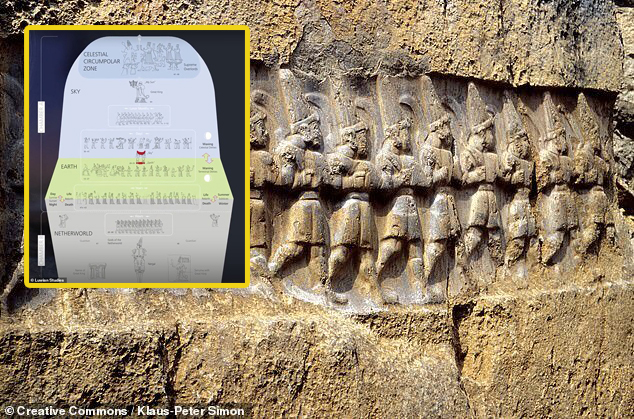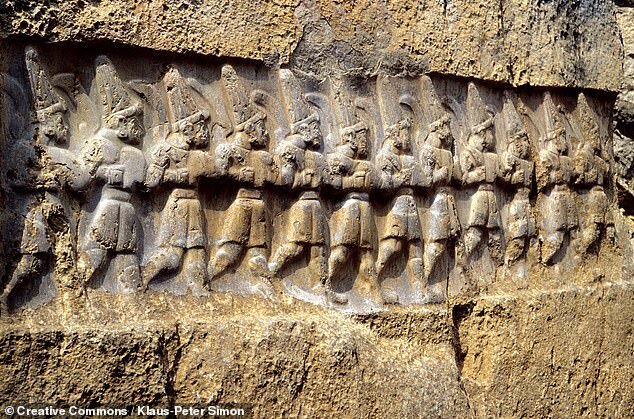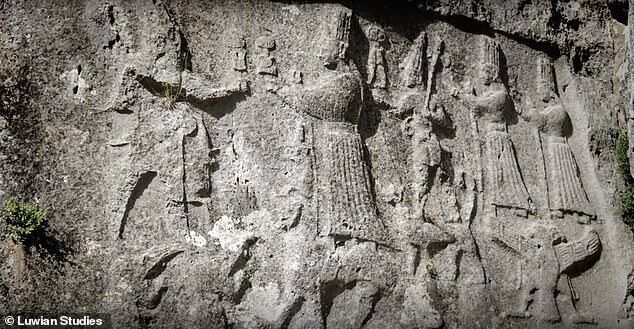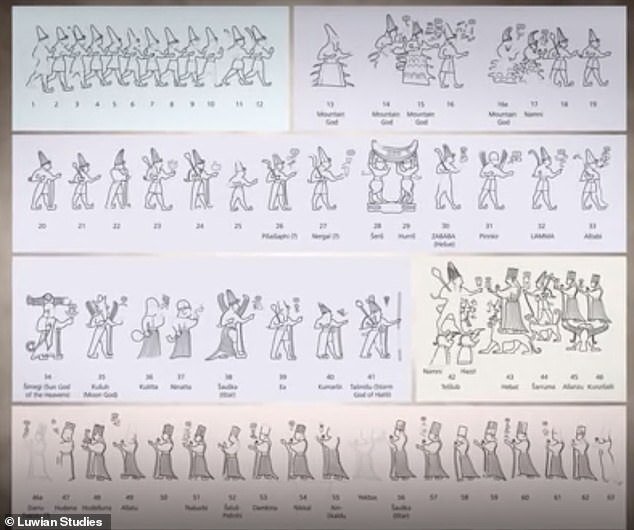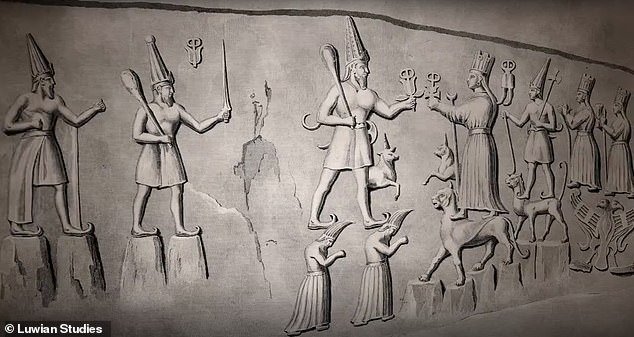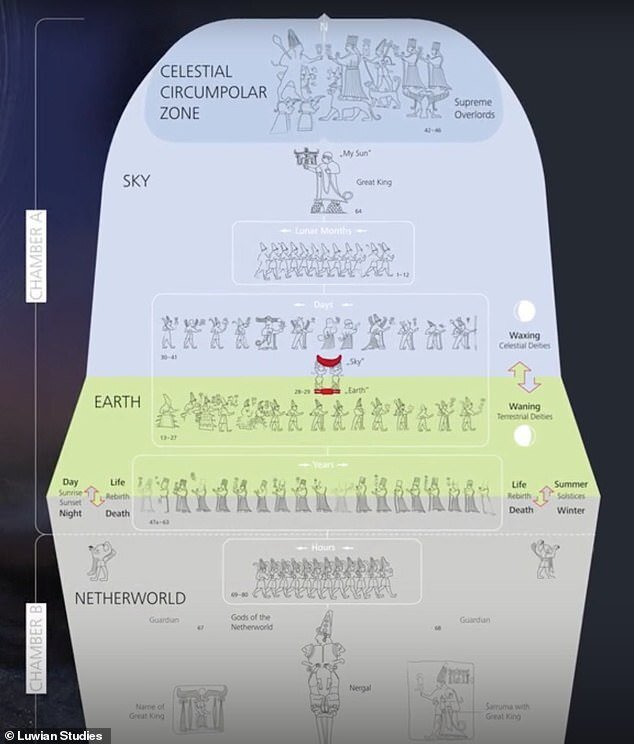According to archaeologists, the cryptical 3,200-year-old stone carvings in Turkey are likely to be an astronomical map of the cosmos and an ancient calendar.
Charles Texier, a French historian and archaeologist excavated the Yazlkaya rock sanctuary in central Turkey, some 100 miles from Ankara, in 1834.
Researchers found more than 90 figures—gods, animals, and monsters—carefully carved out of the limestone bedrock in two chambers, with a temple erected in front of them.
The rock sanctuary,’ a UNESCO cultural heritage site, has long been recognized as a significant Hittite monument. Still, scholars have taken nearly 200 years to figure out what the figures mean.
According to an international team of scholars, the reliefs now symbolize the cosmos—the Earth, heavens, and underworld—and describe the Hittites’ core creation narrative, from chaos to order.
Like an ancient calendar, the relief doubles as a chronicle of the passage of the days, months, and seasons, much like life and death are in an eternal cycle.
The sanctuary, which is known as ‘Yazlkaya,’ or ‘inscribed rock,’ is located atop a massive limestone outcrop, a few miles northeast of the Hittite capital of Hattusa.
The ‘Sistine Chapel’ of Hittite sacred art consists of two roofless limestone rooms with dozens of carved images.
The sun-goddess Hebat and the storm-god Teshub, the Hittite pantheon’s supreme deities, are depicted on the prominent northern wall.
Lesser deities parade in two processions towards the power couple on the east and west walls on either side of the chamber.
‘It is still by no means evident today what purpose the rock sanctuary fulfilled,’ German archaeologist Jürgen Seeher wrote in 2011, although modern Europeans first saw it in 1834.
According to recent research published in the Journal of Skyscape Archaeology, the sanctuary was considered a symbol of how the Hittites regarded the cosmos.
The reliefs describe the various levels of the universe, including the underworld, the Earth, the sky, and the most prominent deities.
However, they also represent ‘the cyclical processes of regeneration and rebirth,’ as lead author Eberhard Zangger put it in a statement: ‘Day and night, the phases of the moon, and the seasons.’ According to Zangger, more than 90 figures follow this system.
Zangger, president of the Luwian Studies Foundation in Zurich, Switzerland, and University of Basel archaeologist Rita Gautschy, studied the layout and composition of the figures.
They discovered that moon phases and solar years are different. In 2019, researchers claim the Hittites used the carvings as a kind of calendar, sliding stone markers back and forth along benches beneath the carvings to keep track of the change of time.
In 2019, Zangger told New Scientist, “Yazlkaya has an atmosphere to it.” ‘Part of it is because it’s a mystery, and part of it is the natural beauty of the location.’
The carved god’s procession on the western wall is divided into 12 figures and 30 figures.
Meanwhile, there are 17 deities on the eastern wall, but Zangger and Gautschy believe there were previously two more. These gods’ numbers — 30, 12, and 19 — would have related to the moon cycle and the passing months.
The lunar days, months, and a third, 19-year cycle that was part of a calendar adjustment would have been kept track of with markers under each line of gods.
The Hittites, according to Gautschy and Zangger, used the final procession of 19 carved gods to keep track of their progress through the Metonic cycle and figure out when to add the essential extra month every 19 years. An additional month would be added to the calendar every 19 years to keep up with the solar year in the so-called Metonic cycle.
It was previously anticipated that calendars based on the complex Metonic cycle were not be created for another 700 years. ‘In the 2nd millennium BC, we would probably not expect knowledge of the 19-year cycle,’ Gautschy said to New Scientist.
More recently, Zangger and Gautschy worked with E. C. Krupp, director of the Griffith Observatory in Los Angeles, and historian Serkan Demirel of Turkey’s Karadeniz Technical University to analyze the shrine’s overall symbolic meaning.
Both Chambers A and B were described as ‘ritual places,’ ‘served as a stage for important ceremonial action involving some special audience,’ according to the writers. Chamber B, they say, represents the underworld, as demonstrated by a relief of the sword god Nergal. ‘The gods were illustrated in great detail on a grand scale,’ they noted. This isn’t just computation; it’s staging.’
Because the supreme deities are found in the north on the cosmos map, they are linked to the circumpolar region of the northern sky, where the stars never set below the horizon and can be observed all year.
‘They rule inexorably from on high,’ Zangger added. They noted that the reliefs ‘may be split into groups designating days, synodic months, and solar years.’ ‘We propose that the sanctuary as a whole is a symbolic depiction of the cosmos, with its static levels (earth, heaven, and underworld) as well as the cyclical processes of renewal and rebirth (day/night, lunar phases, summer/winter).’
According to Hittite culture, astronomical information was displayed so that the shrine adhered to the whole expression of cosmic order.’ The Hittites established their kingdom in the late 17th century BC, most likely between 1680 and 1650 BC, on the Anatolian peninsula in modern-day Turkey. They ruled over most of Turkey and most of the Middle East and Upper Mesopotamia, at their peak in the mid-1300s BC.
The term ‘Hittites’ appears multiple times in the Old Testament, including in Genesis, although experts wonder whether they relate to the same people or a separate group. By 1180 BC, the Assyrians defeated and assimilated the Hittites, and they broke up into smaller city-states, some of which survived until the eighth century BC.

